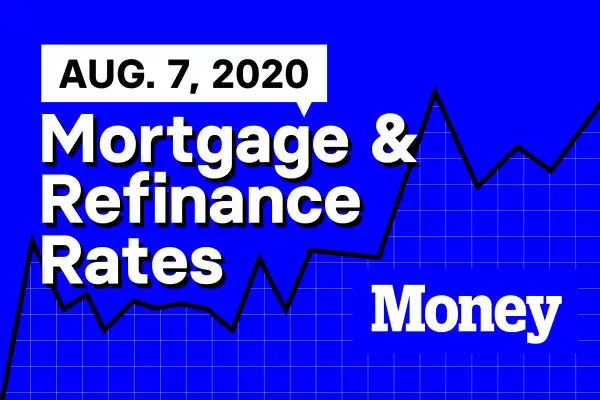Here Are Today's Best Mortgage & Refinance Rates for August 7, 2020

The U.S. economy received a little bit of good news today as more jobs than expected were added during the month of July.
According to the Bureau of Labor Statistics, a total of 1.8 million jobs were added to the economy last month, bringing the unemployment rate down to 10.2%. Experts had been expecting somewhat lower numbers, with a total of 1.48 million jobs added and an unemployment rate of 10.6%.
"The pace of job growth slowed in July, but the gains over the past three months represent an impressive rebound during the ongoing economic challenges brought forth by the pandemic," said Mike Fratantoni, chief economist of the Mortgage Bankers Association, in reaction to the report.
Fratantoni went on to point out that the increase in employment will help sustain the robust recovery in the housing market seen so far. "The MBA's Weekly Application Survey continues to show robust demand for home sales, and record-low mortgage rates are fueling an ongoing refinance wave. Today's report should continue to support both: the return of jobs will keep housing demand strong, and the high level of unemployment ensures that the Federal Reserve will keep rates at zero— meaning mortgage rates will stay low for an extended period of time," he said.
While the better than expected jobs report is positive, the unemployment rate continues to be higher than that attained during the peak of the Great Recession, as the economy still has a long to go before fully recovering from the COVID-19 pandemic.
Week in Review
The first week of August has ended on a mostly positive note for the real estate industry as interest rates for 30-year fixed-rate mortgages hit a historic new low, according to Freddie Mac. It was the eighth new record set since the pandemic hit the United States in March.
Spurred by low rates, buyer demand pushed median list prices 9% higher during the month of June, according to Realtor.com. Actual sales prices for the month were up 5% over 2019 numbers, while housing market activity in the West and Northeastern regions were back up above pre-COVID levels. In the meantime, the number of mortgage loans in forbearance continued its weekly decline, with the MBA estimating 3.8 million homeowners are still in deferred payment plans. While this is still an elevated number, it is down from a high of 4.3 million in June.
New claims for unemployment benefits were also lower than expected this week, with 1,186,000 new claims filed with the Department of Labor. The labor market, despite recent gains, remains severely challenged as many areas experiencing a rise in COVID-19 infections and orders to stay home as much as possible.
Despite low interest rates, mortgage applications for both purchase and refinance loans were down from the previous week by 2% and 7% respectively, although both remained well above 2019 levels according to the MBA's weekly survey. A major stumbling block for the housing market remains a low inventory, as new listings were down 11% year-over-year and the overall inventory was down more than 30%, according to Realtor.com's Weekly Recovery Report.
What are people paying for mortgages right now?
Borrowers with 700 credit scores were charged an average of 3.568% to secure a 30-year fixed-rate purchase mortgage on Tuesday, according to Money's survey of over 8,000 mortgage lenders across the country. The average rate for a 30-year refinance was 4.525%.
Average Refinance Rates Today
A homeowner with excellent credit who qualifies for the lowest rates as reported by Freddie Mac can save a significant amount of money when refinancing. A year ago the average mortgage rate was 3.60%. A homeowner with a $250,000 mortgage balance paying 3.60% on a 30-year loan could cut their monthly payment from $1,137 to $1,038 by financing at today’s lower rates. (It is important to consider closing fees and that refinancing could reset the clock on your mortgage, meaning you will have to make payments longer.)
How do you find the best mortgage rates?
Economist Ralph McLaughlin, writing in the HAUS Report on what it takes to get the lowest rates:
Conventional wisdom suggest that improving one's credit profile before buying a home or refinancing is the key to getting the best rate. While doing so can certainly help, the benefit may not be as large or as easily obtainable as one might think."
For more on how to get the lowest mortgage rates, read: Mortgage Rates Are at Record Lows: But What Does It Take to Actually Qualify for a 3% Loan?
What are today’s advertised rates?
Of course, mortgage rates vary widely by location and personal factors like the size of your down payment and your credit score. Here are today’s advertised mortgage rates at some of the mortgage industry’s largest lenders. (All rates are APRs. The rates you see may be different.)
JP Morgan Chase
Based in New York, JP Morgan Chase has nearly 5,000 U.S. branches.
Mortgage rates advertised for August 7:
30-year fixed: 2.835%
15-year-fixed: 2.495%
5-year ARM: 2.665%
(Rates based on New York City zip code 10006.)
Wells Fargo
Based in San Francisco, Wells Fargo has more than 7,000 locations.
Mortgage rates advertised for August 7:
30-year fixed: 2.996%
15-year-fixed: 2.720%
5-year ARM: 2.851%
Quicken
Quicken, a non-bank lender based in Detroit, is the nation’s largest mortgage lender by dollar origination volume. Quicken's parent, Rocket Companies, recently went public.
Mortgage rates advertised for August 7:
30-year fixed: 3.139%
15-year-fixed: 2.924%
(Quicken doesn’t advertise a five-year adjustable rate.)
Bottom Line:
Everything You Need to Know About Mortgage Rates in 2020
Mortgage Rates Drop to 2.88%—The Lowest Ever Price for a 30-Year Home Loan
How to Get Preapproved for a Mortgage: A Step-by-Step Guide for Homebuyers

